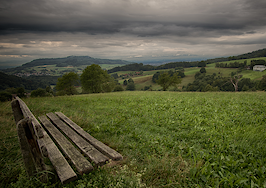At Doora Properties, we recently launched two vacation rental properties in Big Bear. These investments are uniquely suited to our business model and allow us to showcase our design and staging capabilities in a real-world setting.
A few months ago my wife and I found one of these Big Bear cabins on a wholesale platform and purchased it sight unseen. It’s in an area where we knew we had wanted to have a house for a long time, and from the photos included with the listing we had a fair idea of what we were getting.
Thirty days after we opened escrow, we closed: no inspections, no contingencies, no site visit. It was after closing that we walked into the house for our first time.
Now, is this something I’d recommend for everyone to do? Definitely not. However, as a seasoned investor and someone who is comfortable looking at photos and determining what needs to be done, the inherent risk was worth it for me.
We had a plan and knew exactly what we wanted to do to the property and in just under 60 days our vision became reality: a gorgeous vacation home designed and decorated to the nines and ready to monetize on the rental market.
If your clients have expressed interest in vacation rentals as a real estate investment or if you are interested in getting into this market, there are some things to consider both before and after you invest. While they can be a great investment, they require more handholding than other types of investments and can be more vulnerable to changes in taste and perception.
If you’re thinking about investing in a rental property, either locally or in an out-of-town market, here are some of the things to keep in mind, especially if you can’t get boots on the ground before making an offer.
Buy with upside potential in mind, just as you would with any other investment
You know the old saying: You make your money on the buy, not the sell side. This is no time to get impulsive and to overspend beyond where you are comfortable. Take the emotion out of the equation and make solid decisions based on the numbers you have put together.
While you may crunch the numbers and look for ongoing profitability as your primary criteria, you need to invest with an eye on your eventual exit strategy. Look for a property that will hold or increase in value or look for one that can be converted to a long-term rental property if there are changes to the market.
Understand the scope of your updates and upgrades
Have a solid idea of the updates and upgrades you’ll be making to the space. For some rental properties, you’ll be using builder-grade materials and holding off on fancy bells and whistles. In more upscale markets, however, luxury fixtures and finishes are essential.
We were lucky that the gamble of going without contingencies paid off in our case but we could have easily run into unexpected repairs. Always make sure that you have left yourself some money to take care of unforeseen changes, if necessary.
Either way, make your decisions with your head, not your heart. Remember, you won’t be living there so you don’t need to fall in love with the changes you make.
Hire a professional management company and interview several
Long-term rental management is different from vacation rental management. The focus is different and the timeline for communication is different, as well. Make sure that the property management company you choose is set up for the demands of the type of rental market you’re appealing to and that they offer the menu of services you’ll need in order to be successful and garner the rave reviews that will keep your property filled.
In Big Bear, we found the perfect company and manager for our rental. Make sure that you are working with a property manager with experience specifically in the short-term rental market. The requirements are significantly different from SFR; you need to make sure your property manager is set up for the additional services and tighter turnaround times required.
In addition, make sure that your management company is set up for the market segment you’re targeting. For instance, a luxury rental requires a different level of service than more modest accommodations.
Convert an existing property, if at all possible
If you have an existing property, whether a vacation home or an inherited property, try to convert it to a vacation rental. It is more than likely already furnished and well-stocked with the essentials, ready to plug and play with some updates or upgrades.
If you’re shopping for a setup that is already complete, make sure that the reviews are good and that the property makes sense for the market. If at all possible, find out why the current owner is selling and ensure that there are no HOA or local restrictions on the horizon that could affect your plans.
Follow some of the relevant Facebook groups and look online for tips from tried-and-true hosts
There is no need to reinvent the wheel or figure everything out on your own. Get active in online communities of vacation rental owners and folks who are located in the area where you’re investing. You’ll learn from their mistakes, you’ll start to get a handle on the best service providers, and you’ll find out what value-added amenities and features are most popular with guests in the area.
It took us almost two months to get up and running. That’s two months of money going out and nothing coming in. You need to know how long it’s going to take you to start renting out the property. This is especially important in the case of markets where rentals are primarily seasonal and where you may end up going several months of the year without consistent income.
Owning and operating these properties has been both eye-opening and fun, offering new insights into this segment of the investment market along with profitability. Whether it’s you or your client who’s looking at this as a possibility, you’re sure to learn from the experience.
Troy Palmquist is the founder and broker of DOORA Properties in Southern California. Follow him on Instagram or connect with him on LinkedIn.













